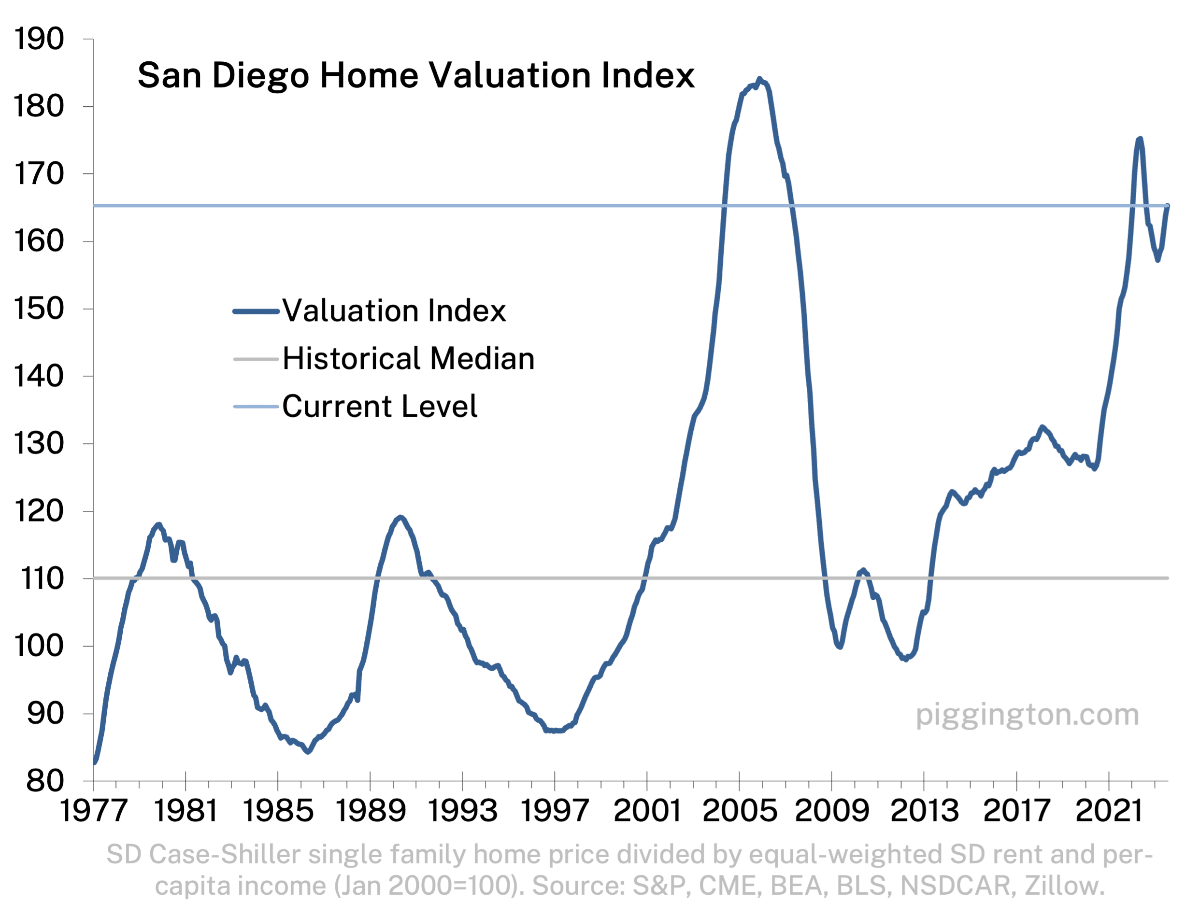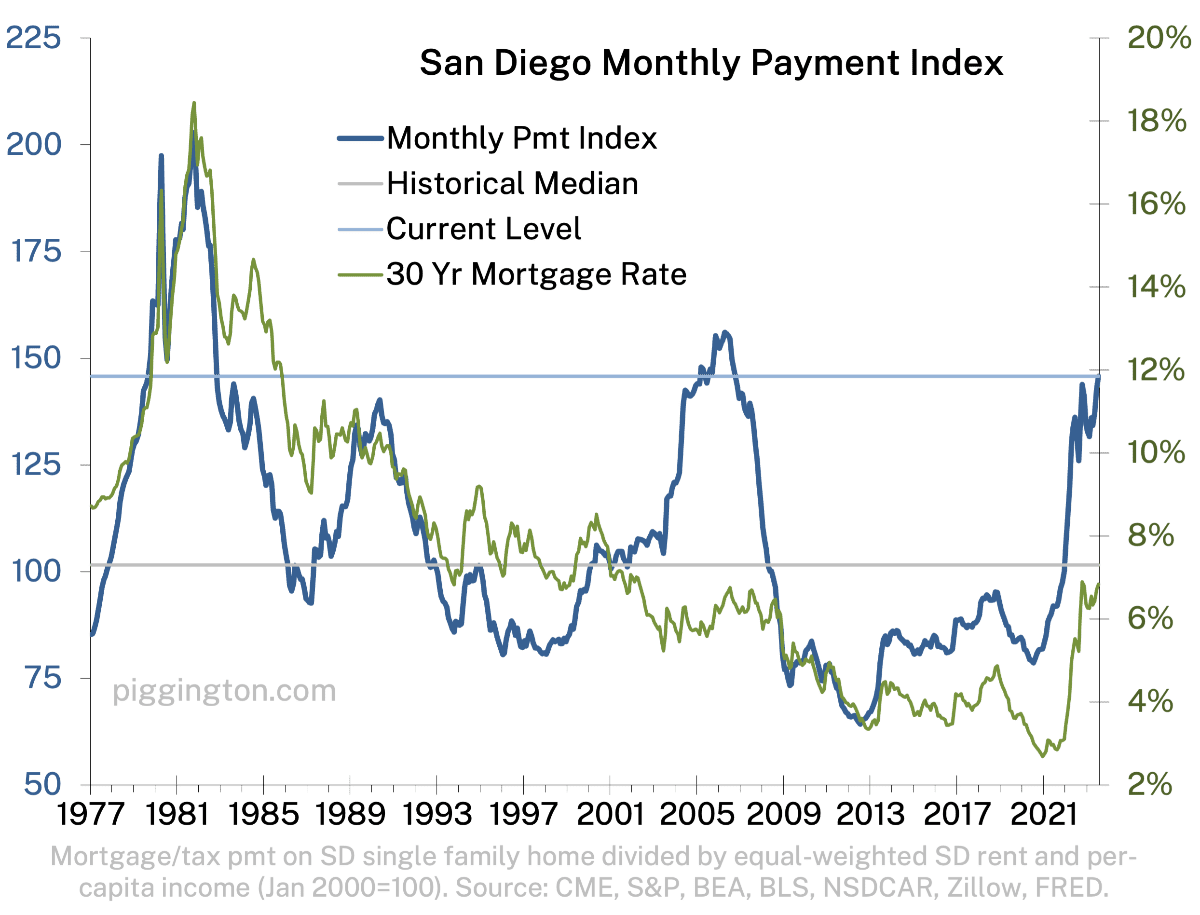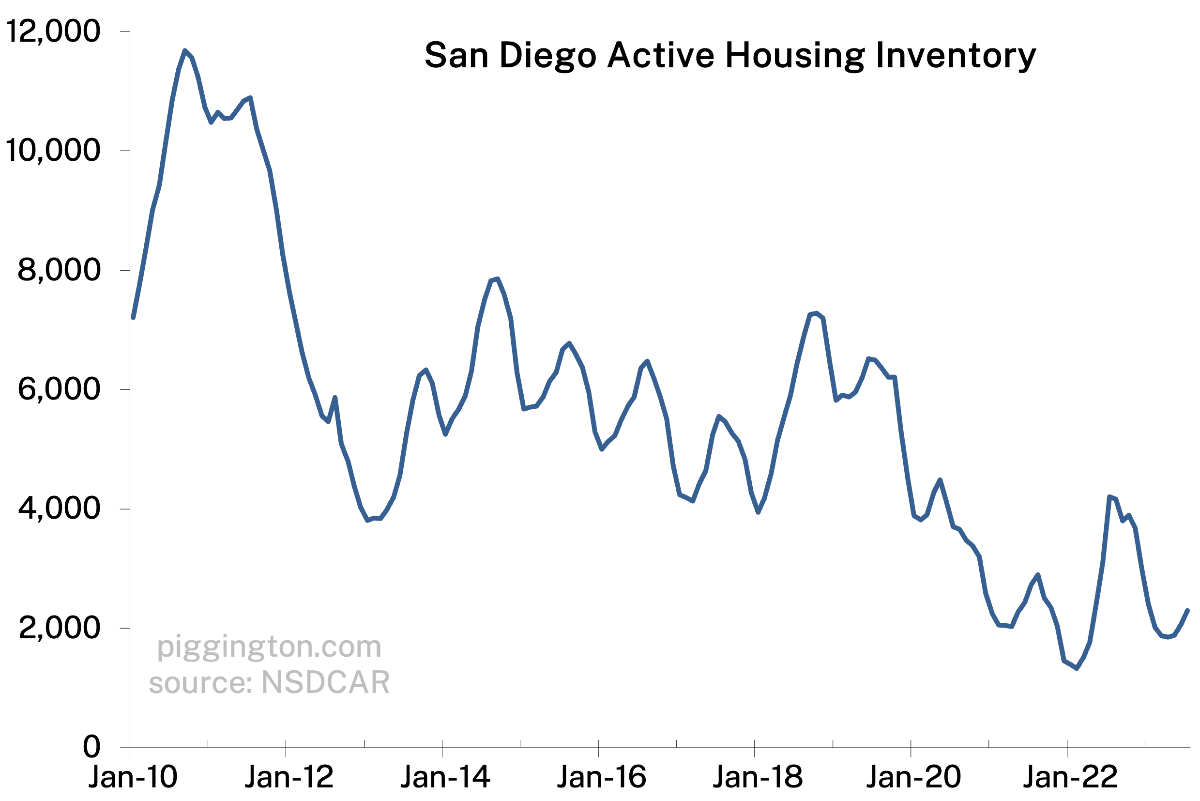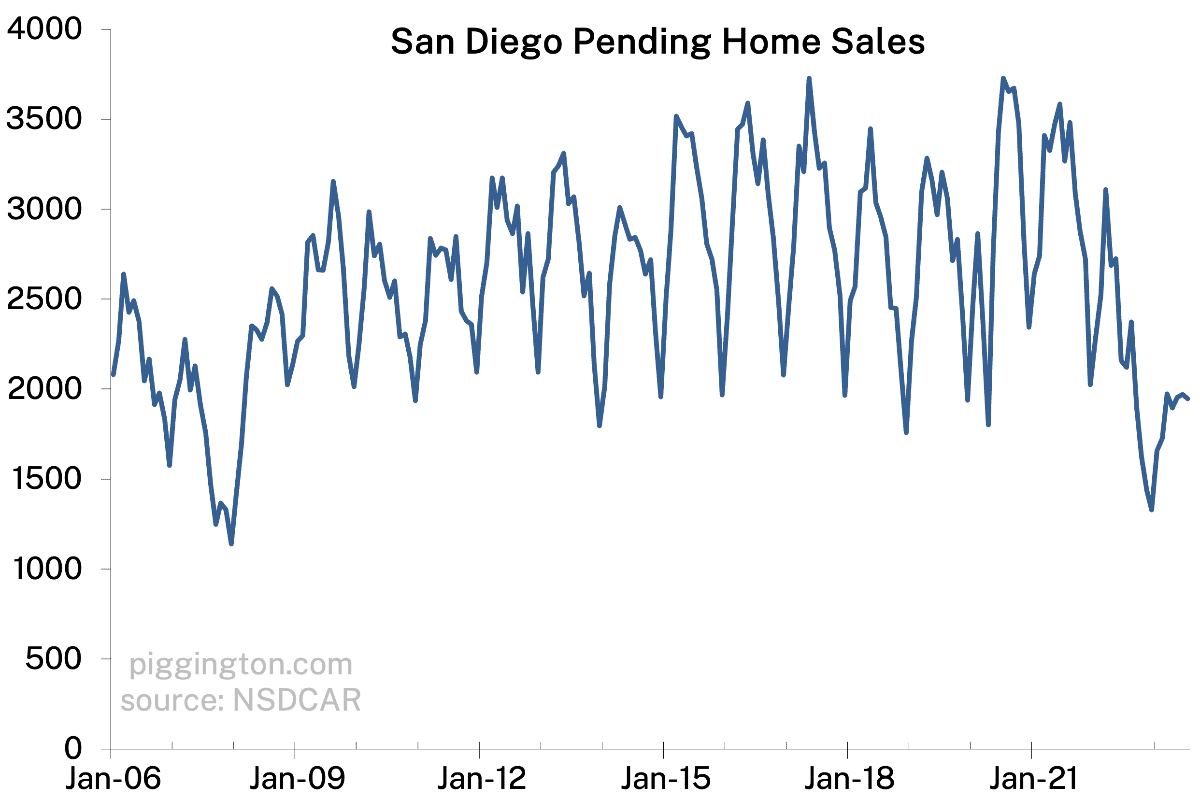The bounce back in prices this year has dragged up both the valuation index, and the monthly payment index (the latter to a new high for the cycle, thanks to stubbornly high mortgage rates).


In the prior valuation update, I discussed some potential long-term outcomes. My views haven’t really changed on that issue so I refer you to that article if you’re interested.
Here I’ll share some thoughts on how prices have held up so well, despite the dramatic rise in mortgage rates. (With the disclaimer that I’m not a housing economist, or any kind of economist… these are just the musings of an amateur).
To begin with, you can toss all San Diego-specific rationales out the window. National home prices have held up a bit better than San Diego prices, both from their low point earlier this year and their high point in 2022:
 I think there are two main factors at work here.
I think there are two main factors at work here.
First, the job market is on fire. Here are some stats. (Yes it’s Twitter, but the author is a legit macro dude. No, I will not call it “X”).
Second is the oft-discussed “rate lock”: people with pre-2022 mortgages don’t want to sell and give up their low rates. And thanks to the healthy job market, few of them have to. (To be clear, I’ve definitely been surprised by the strength of this effect!)
So the rise in mortgage rates did crater demand. But the rate lock/strong job market combo cratered supply just as much. Here are some charts showing that both supply and demand are near historical lows:


These two shocks have offset each other such that, despite the underlying craziness, prices are just kind of creeping up as if things were normal.
What could disrupt this equilbrium? I think the biggest vulnerability would be a serious weakening in the job market. (I’m not predicting that will happen, just that it would upset the equilbrium if it did). This would result in fewer buyers, as well as more sellers — the desire to hang onto a sweet mortgage rate doesn’t amount to much someone is forced to sell due to job loss or relocation.
It’s harder to assess the potential impacts of interest rate changes, because of the offsetting effects involved. A reduction in rates increases affordability/demand, but also increases supply as homes become un-rate-locked. And vice-versa for rising rates.
What about if rates just stay where they are? Again, there are some potential offsetting effects.
- On the positive side, higher rates imply higher inflation in rents and incomes, which would be supportive of nominal (though not necessarily real) home prices.
- On the negative side:
- The farther we get from the low-rate salad days, the more homeowners will have post-2022 mortgage that aren’t subject to rate lock, potentially freeing up supply.
- Also, it seems to me that a lot of buyers are ignoring the steep monthly price tag and buying now with the intent to refi “when” rates go back down. The longer rates stay high, I suspect, the smaller this contingent will get, as more people will start to wonder whether that “when” is actually an “if.”
So those are my thoughts on the near term. Very short version: watch the labor market.
For the longer term, the very brief version is that the following all seem like plausible outcomes (listed in descending order of likelihood IMO): a decline in the monthly payment index, a decline in the valuation index, and a decline in nominal prices. I went into more detail on those possibilities in the prior installment.

Yep, it is shocking to me how well the labor market has held up in the face of rising interest rates. But, money supply is still contracting (eight months straight, now), which points to further increases in interest rates and slowing business activity, including labor demand.
https://www.zerohedge.com/personal-finance/credit-crunch-money-supply-has-shrunk-eight-months-row
It is good to see the Petrodollar being dethroned. The Petrodollar led to asset inflation, deindustrialization, warmongering, government growing like Topsy, etc. I look forward to the end of the U.S. Empire.
And, I look forward to the return to sanity, such as reasonable associations between home prices and household income here in San Diego, so young folks can afford to buy a house, again.
Rising rates don’t matter for labor markets as much when business is increasingly capital light, and inflation expectations are such a business can project 4%+ price increases as an average base case.
For the declining share the economy with capital heavy businesses, rising rates also means less competition. For example, investment in the oil and gas sector is quite low despite very high profits. Similar for mining.
I’ll give you one SD specific rationale. Ive been following inventory closely over at CR. Prices are going up more elsewhere because they were much lower and affordability much higher in those places. People dont like the higher prices in mid America but plenty can still afford them.
The inventory declines here in SoCal and in Bay Area have been more significant than other places. Low inventory is keeping us able to tread water in spite of lack of affordability that exists elsewhere. So in short, we are able to maintain pricing due to lower inventory where as other places still have room for slightly higher pricing that we dont
Thanks for the update! Still plodding along. I’ll be cheering if we get a soft landing. It’ll be a while before the labor market cools off and catches up. Unemployment went down again last month(3.5%}, job creation was healthy(187k), and there is still a glut of job openings with a shortage of workers. Seems like we may be close to a sweet spot. 🤞
I’m cheering for higher wages to open doors for younger buyers. A coworker is moving back to the Bay Area because for same rent cost they can get a better house up there compared to SD. Makes me think rents will decrease much sooner than prices will recede.
The resilience of the labor market is not a surprise given the rapidly aging population and greater barriers to migration (both trends hugely accelerated by covid). As the boomers have left the workforce they are also sitting on $75 trillion of assets which they are spending primarily on services and healthcare. Fiscal policy largely dictated by this same voting demographic will continue the spending binge. So there will be no respite from high rates anytime soon; the story that inflation is cooling is largely due to base effects and when core CPI settles at 4% the Fed will eventually have to scrap their 2% target. In the face of this prolonged high rate environment, SD house prices will chug along at below trend growth for a year or two; effectively waiting for wages to catch up a bit before resuming the ridiculousness.
Here’s a mid america anecdote for you.
In a market in a non-metropolitan upper midwest county of 40k with a slightly growing population and average incomes, SFH prices rose from about 60/sf to 100/sf between early 2020 and now. New construction is ~170/sf. Inventory is even tighter than here.
Even tighter than the sale market is the rental market. In the same 3 years basic one bedrooms without covered parking have gone from 500 to 900. It’s just crazy to see middle of nowhere places with San Diego 2012 rental prices.
The WFH trend is eveywhere. In small towns, it hits for example local/state gov employees, insurance agents, mortgage brokers, and high income professionals like lawyers and accountants and their admin staff.
When you are home all day you don’t just need home office space, you need more space period since you’re there more overall. And you need a ton more space with two people working from home since conference calls and zooms can be really loud and annoying when you’re trying to work on your own projects.
I am about to close on a 5-bedroom 3-bathroom 2700sf home.
Total price of $194,300 reflects the fact I am paying cash, so getting it 7% below list in a hot local market. Same as here really: prices high but currently on a breather, inventory well under half of normal.
Someplace a lot colder than St George. There is a free public outdoor skate rink 2 blocks away.
The price also reflects that the upstairs bathroom has no shower, only a clawfoot tub. So this will be needed ASAP.
https://www.vintagetub.com/showers/clawfoot-shower-enclosure-sets.html
I wish I could figure out the difference between the $300 and $900 and $1500 versions. Plastic versus brass? They look basically identical online.
[…] version of the below graph. However, they remain firmly in nosebleed territory, and as I discussed here, rate moves seem to cause offsetting reactions in supply and demand. So it remains to be seen how […]
[…] I’ll touch on that more in the next valuation update, but for now, my views as of the last valuation update haven’t changed […]
[…] one from Feb 23 discusses potential outcomes in declining order of probable-ness. The only thing I’d add here is that the sharp rise in months of inventory lately raises the […]